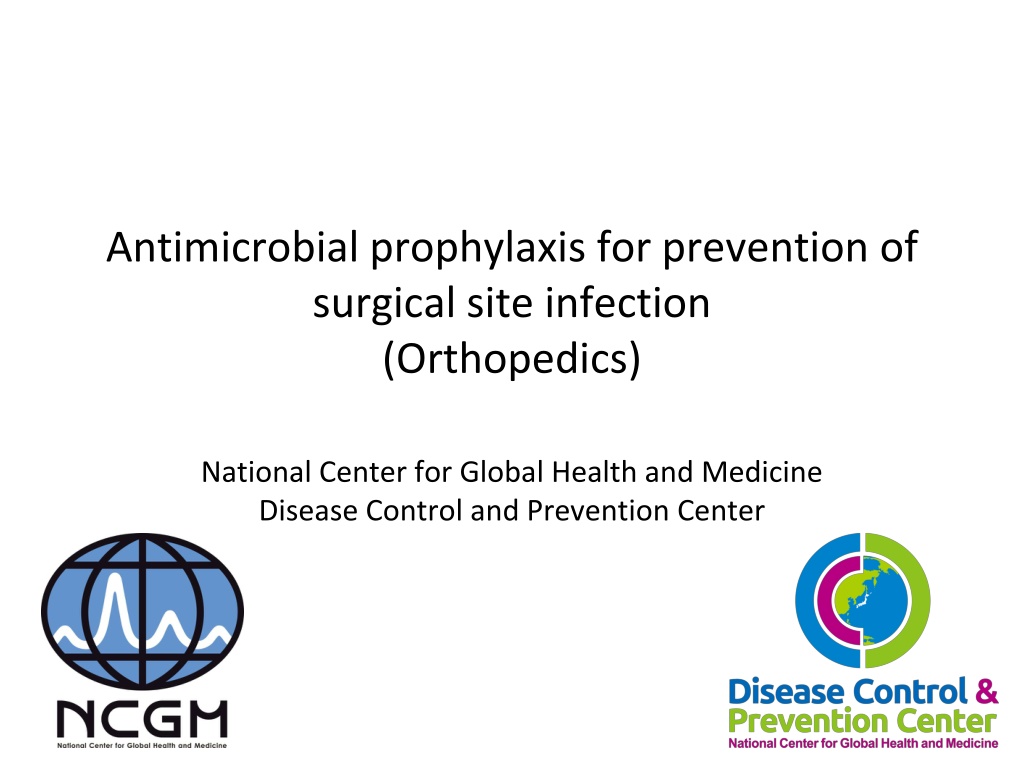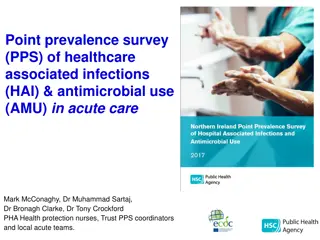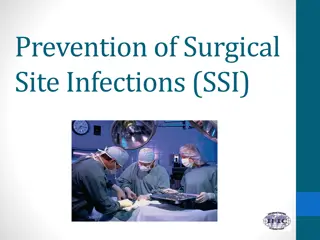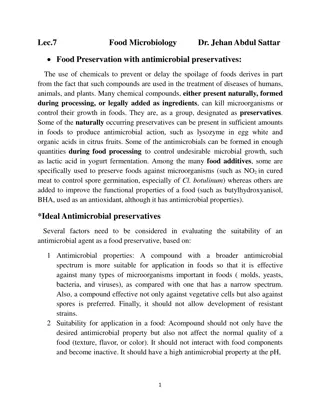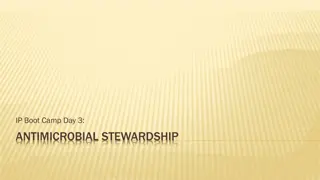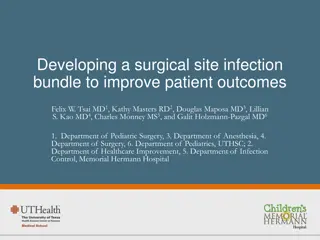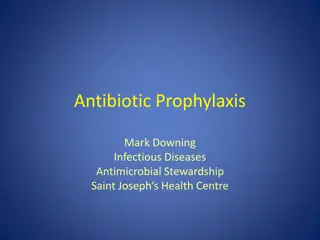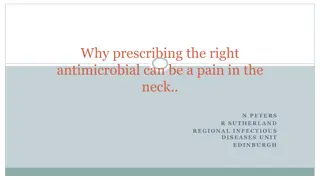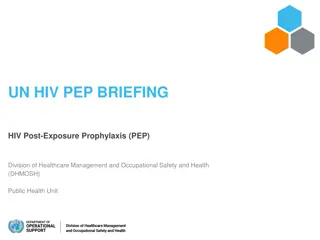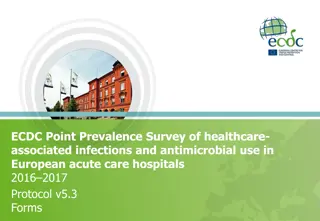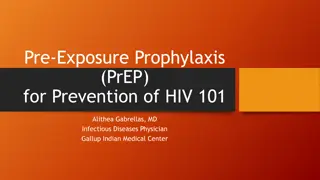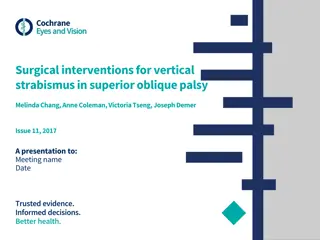Antimicrobial Prophylaxis for Surgical Site Infection Prevention in Orthopedics
Surgical site infections (SSIs) are common and costly healthcare-associated infections, accounting for a significant percentage of nosocomial infections. Defined by the CDC, SSIs occur within 30 days of surgery and have clinical criteria such as purulent exudate, positive cultures, or surgeon diagnosis. Various wound classifications impact SSI rates, with clean surgeries having lower rates than contaminated or dirty procedures. The timing of prophylactic antibiotic administration significantly affects SSI rates, making it crucial for successful prevention. Microbiology considerations vary based on the type of surgical procedure, with different pathogens to consider for clean versus clean-contaminated surgeries.
- Orthopedics
- Surgical Site Infection
- Antimicrobial Prophylaxis
- Wound Classification
- Prophylactic Antibiotics
Download Presentation

Please find below an Image/Link to download the presentation.
The content on the website is provided AS IS for your information and personal use only. It may not be sold, licensed, or shared on other websites without obtaining consent from the author. Download presentation by click this link. If you encounter any issues during the download, it is possible that the publisher has removed the file from their server.
E N D
Presentation Transcript
Antimicrobial prophylaxis for prevention of surgical site infection (Orthopedics) National Center for Global Health and Medicine Disease Control and Prevention Center
Introduction SSIs are the most common and the costliest healthcare- associated infections. Among surgical patients, SSIs account for 38 percent of nosocomial infections in US. It is estimated that SSIs develop in 2 to 5 percent of the patients undergoing surgical procedures each year. JAMA Intern Med. 2013 Dec;173(22):2039-46.
skin superficial subcutaneous tissue soft tissue: myofascia and muscle deep organ/space organ/space SSI
Definition of SSI by CDC Infection related to an operative procedure that occurs at or near the surgical incision (incisional or organ/space) within 30 days of the procedure or within 90 days if prosthetic material is implanted at surgery. Clinical criteria for defining SSI include one or more of the following A purulent exudate draining from a surgical site A positive fluid culture obtained from a surgical site that was closed primarily A surgical site that is reopened in the setting of at least one clinical sign of infection (pain, swelling, erythema, warmth) and is culture positive or not cultured The surgeon's diagnosis of infection Surg Infect (Larchmt). 2013 Feb;14(1):73-156. Am J Infect Control. 2008;36(5):309.
The wound classification and the SSI rate Clean(defined as uninfected operative wounds in which no inflammation is encountered and the wound is closed primarily) 1.3 to 2.9 most of orthopedic surgeries are clean operation. Clean-contaminated 2.4 to 7.7 Contaminated 6.4 to 15.2 fresh accidental wounds are clean operation. Dirty 7.1 to 40.0 old traumatic wounds with retained devitalized tissue, foreign bodies, or wounds that involve existing clinical infection Surg Clin North Am. 1980;60(1):27. Am J Epidemiol. 1985;121(2):206. Ann Surg. 1984;199(3):253. Am J Med. 1991;91(3B):152S.
Timing of prophylactic antibiotic administration and subsequent rates of SSIs Time of Percent with Odds ratio 95 percent CI administration* SSI Early 3.8 4.3 1.8-10.4 Preoperative 0.6 1 - Perioperative 1.4 2.1 0.6-7.4 Postoperative 3.3 5.8 2.4-13.8 "Early" denotes 2 to 24 hours before incision, "preoperative" 0 to 2 hours before incision, "perioperative" within 3 hours after incision, and "postoperative" more than 3 hours after incision. N Engl J Med 1992; 326:281.
Microbiology Clean procedures: skin flora, including Streptococcal species, Staphylococcus aureus, and Coagulase-negative staphylococci Clean-contaminated procedures: gram-negative rods and enterococci in addition to skin flora.
Antimicrobial prophylaxis for orthopedic surgery Usual Nature of Common Recommended Redose adult operation pathogens antimicrobials interval dose* Clean operation involving hand, knee, or foot with None no implantation of foreign material Spinal procedures <120 kg: 2 g IV Staphylococcus Cefazolin Four hours 120 kg: 3 g IV Hip fracture aureus, Internal fixation 15 mg/kg IV Staphylococcus OR vancomycin N/A resistant Staphylococcus aureus (MRSA) and Staphylococcus epidermidis are a frequent cause of postoperative wound infection, in patients previously colonized with MRSA, or for those who Total joint (max 2 g) epidermidis replacement OR clindamycin 900 mg IV Six hours Surg Infect (Larchmt) 2013; 14:73.
Duration of Antimicrobial prophylaxis There are no evidences that longer duration of antimicrobial prophylaxis will reduce the rate of SSI. In general, repeat antimicrobial dosing following wound closure is not necessary and may increase the risk for development of antimicrobial resistance and C. difficile infection (CDI). For cases in which prophylaxis beyond the time of surgery is warranted, in general, the duration should be less than 24 hours. Aust N Z J Surg, 1998, 68, 388-396. Am J Health Syst Pharm, 2013, 70, 195-283.
Take Home Message Antibiotics should be administered about 1 hour before incision. There are no evidences that longer duration of antimicrobial prophylaxis will reduce the rate of SSI. The choice of antimicrobials should be based on the microbiology of SSI. In clean procedures, gram positive coccus should be covered.
